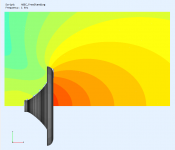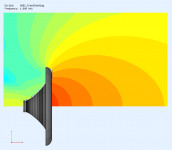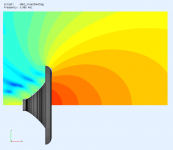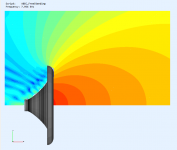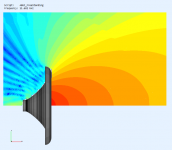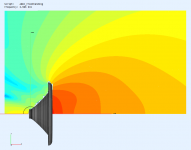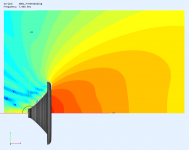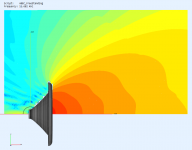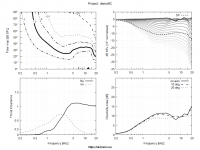I'm currently using a big JMLC 350hz horn that is just magical because (I think?) The DI is low. Listening to Bille Eilish whispering puts the hairs up on the back of your neck, and big scale orchestra is just more exciting than on other speakers.
But it beams so much at the top that it's frustrating to live with in an open plan house as I walk around.
What you experience with the JMLC horns is what Jean-Michel referred to as "smoothness of the pressure field".
He considered the acoustic load to be a very important parameter, since a resistive and constant acoustic impedance ensures optimal operation of the driver.
The inevitable drawback is beaming.
It can be made worse (much worse, of course), no doubt about that. The above was the "sandhorn". This is the demo8C.cfg from the released Ath package.
(3 dB step division)
But all of this shows in the polar maps. That's what we are interested in in the end, isn't it. I simply don't see a "smoothness of the pressure field" as an overlooked mystical quantity. Definitely it's not a privilege of beaming horns, that's clear. And it has obviously nothing to do with loading.
(3 dB step division)
But all of this shows in the polar maps. That's what we are interested in in the end, isn't it. I simply don't see a "smoothness of the pressure field" as an overlooked mystical quantity. Definitely it's not a privilege of beaming horns, that's clear. And it has obviously nothing to do with loading.
Attachments
Last edited:
I think what the Le Cleac'h profile provided was a smooth curve and a good termination, in optimising the loading etc. the polar performance was compromised.
Mabat's latest examples show that the smoothness doesn't have to be at the cost of polar performance. This is very promising as many anecdotally praise the on axis sound of Le Cleac'h horns so it seems like it could be a could compromise.
Mabat's latest examples show that the smoothness doesn't have to be at the cost of polar performance. This is very promising as many anecdotally praise the on axis sound of Le Cleac'h horns so it seems like it could be a could compromise.
I ran some simulations on the effect on the waveguide output in the presence of a woofer and a woofer cut into the waveguide. I have posted them in my ABEC thread to avoid cluttering mabat's.Any comments on my proposal to nest the woofer into the horn and use the C to C interference to maintain pattern control down to frequencies where it is usually lost?
2 way waveguide speaker build ABEC modelling
I ran some simulations on the effect...
Thank you very much, that's most helpful indeed.
I will make any further comments in your own thread.
Best wishes
David.
Is that astrology?
Not really, although in this aeon the dividing line between astrology / spirituality and astronomy / (quantum) physics seems to be fading

Back to the audio bubble: do you happen to have sims of horns with k between 3 and 4?
Last edited:
This might be of interest to you guys too.
I recently had Erin from Erin's Audio Corner on my podcast. We talked about his recent acquisition the $100k Klippel NFS
Erin's Audio Corner buys the Klippel Near Field Scanner System (NFS) - YouTube
I recently had Erin from Erin's Audio Corner on my podcast. We talked about his recent acquisition the $100k Klippel NFS
Erin's Audio Corner buys the Klippel Near Field Scanner System (NFS) - YouTube
So jwtrace - we will have to be prepared to see your advertisement of your new vlog both here and there in the future it seems... I think you should do an announcement in the commercial area.
//
//
But all of this shows in the polar maps. That's what we are interested in in the end, isn't it. I simply don't see a "smoothness of the pressure field" as an overlooked mystical quantity. Definitely it's not a privilege of beaming horns, that's clear. And it has obviously nothing to do with loading.
Smoothness of the pressure field and loading are 2 (separate) aspects that JMLC considered important.
His objective was to "design horn profiles that are complete and address the entire impedance transformation problem from enclosed driver diaphragm to the open air."
OK. From your previous post it followed otherwise.
JMLC horns represent smooth termination of an exponential horn into free air. That's fine. Polar smoothness is the positive by-product of the shape resulting in high acoustic impedance, the beaming the negative one.
One can definitely have smooth radiation and controlled directivity. As yet I haven't found a way to have high acoustic impedance at the same time. The best I found so far is simply a middle ground.
JMLC horns represent smooth termination of an exponential horn into free air. That's fine. Polar smoothness is the positive by-product of the shape resulting in high acoustic impedance, the beaming the negative one.
One can definitely have smooth radiation and controlled directivity. As yet I haven't found a way to have high acoustic impedance at the same time. The best I found so far is simply a middle ground.
Maybe the problem is that we reach for BW>3oct, 3 octaves being as I learned a limit for a (very?) well behaved horn. Its probably all in the impedances...
//
//
Regarding waveguides alone, that's just a matter of size. There's nothing problematic towards high frequencies. It's the low end that's difficult. And then there are the real-world drivers, that's a different problem.
The way it redefines the wavefront shape at the same time as letting it go on a continuous basis.Polar smoothness is the positive by-product of the shape
- Home
- Loudspeakers
- Multi-Way
- Acoustic Horn Design – The Easy Way (Ath4)
